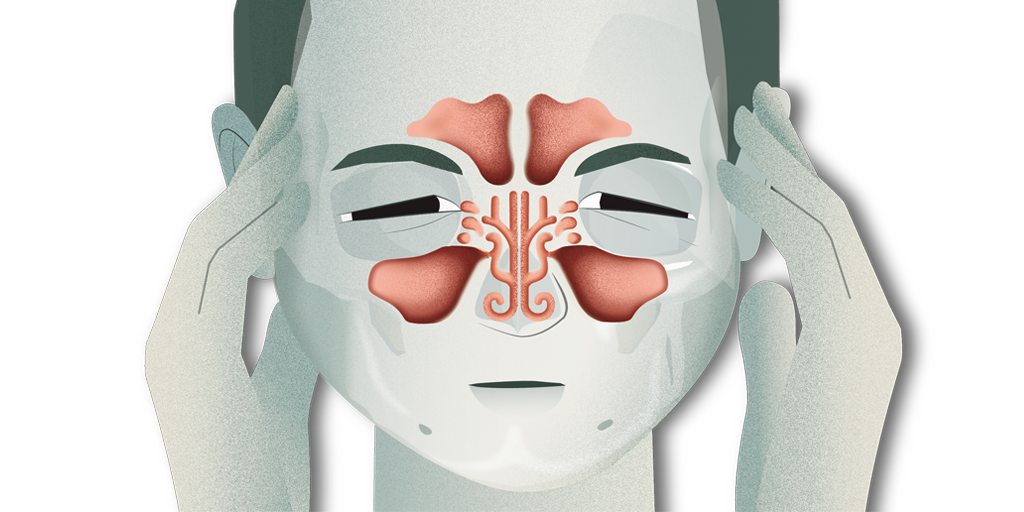Table of Contents
Sinus is the name given to certain narrow cavities of the body. From each side of your face there are four sinuses that excavate the bones surrounding the nasal passages: the maxillary sinus is located beneath the cheeks, above the teeth; the frontal sinus is situated within the frontal bone above the nasal bridge; the sphenoidal sinus is located behind the nasal pit, inside the body of the sphenoid bone; and the ethmoïdal sinus, it is actually made up of several small cavities, housed in the ethmoid bone between an orbit and the corresponding nasal fossa.
Sinusitis
Sinusitis is an inflammation of the mucus of one or more of those four cavities due to viral, bacterial or fungal infection. The infection causes the sinus mucosa to swell and produce excess secretion that clogs the cavities, leading to annoying and painful symptoms. When the sinusitis affects all the sinuses on one or both sides of the nose, it is called pansinusitis.
Sinusitis Causes
The lining of your sinuses produces permanently a mucus protection. Along with thousands of cilia that line the sinusoidal cavities, that mucus protects the paranasal sinuses against foreign particles and micro-organisms that try to enter. These particles are trapped and returned to the nose to be expelled outside. Sometimes, unfortunately, microorganisms penetrate the sinuses causing them to become swollen; this medical condition is called sinusitis.
Usually sinusitis starts following a cold, flu or an untreated viral infection. The disorder causes an abnormal accumulation of secretion in the sinuses and depriving them of oxygen, thus facilitating multiplication of bacteria. The bacteria proliferation provokes a painful swelling of the nasal mucosa. Being inflamed, the mucosa exerts pressure on the sinus tissue prevent the mucus from flowing out. Certain factors such as inadequate fluids intake and cigarette smoke can worsen the blockage.
Depending on the severity of the inflammation, a sinusitis can be acute, subacute or chronic.
Acute sinusitis – Acute sinusitis is usually occurs as the result of a flu or cold; usually, it heals in less than 4 weeks, and the symptoms are less severe. It can be caused by:
- Dental abscess
- Allergies
- Air pollution
- Nasal polyps
- Use of nasal sprays
- Cigarette smoke
- Deviation of the nasal septum.
Subacute sinusitis: sub-acute sinusitis almost presents the same symptoms and characteristic as acute sinusitis; the symptoms, however, last for 4 to 8 weeks. Without appropriate treatment, subacute sinusitis evolves to chronic sinusitis.
Chronic sinusitis – generally, a chronic sinusitis lasts longer than 3 months and tends to cause pain and further complications. It may be the result of an untreated acute/subacute sinusitis or a problem with allergies, pets, mites, pollen, fungi, or certain airborne chemicals. Seasonal allergies such as hay fever can also be the root of a chronic sinusitis. In addition, diabetes, cystic fibrosis or AIDS increase considerably the risk of chronic sinusitis. Other common factors that may be involved in the development of chronic sinusitis include:
- Swimming in polluted water
- Nasal polyps
- Cigarette smoke (active or passive)
- Weakened immune system
- Nasopharyngeal cancer / tumor
- Nasal use of cocaine
- Facial trauma causing obstruction of one or more sinus
- Anatomical abnormality of the sinuses or a deviated nasal septum.
You are more at risk of sinusitis if:
- You are under stress
- You smoke cigarette
- You have cystic fibrosis
- You live in an environment where the air is humid or polluted
- You have a weakened immune system
- You previously had an acute or subacute sinusitis
- You are pregnant
- You have gastro esophageal reflux disease (GERD)
- You have nasal polyps or dental abscesses
- You have an infection of the upper respiratory tract
- You suffer from respiratory allergies such as hay fever or allergic asthma
- You have a congenital abnormality in your nose or sinuses which block the sinus cavities.
Complications
It is very important to treat your sinusitis in its acute phase. If you have chronic sinusitis, the urgency to treat it is even more pressing; the infection can spread to the eyes or brain, causing major problems such as:
- Meningitis
- Brain abscess (also called cerebral abscess)
- Inflammation (thrombophlebitis) of the veins of the eyes
- Infection (osteomyelitis) of the frontal bone, especially in children.
Sinusitis Symptoms and signs
The symptoms of acute sinusitis are the same as chronic sinusitis, the only difference is that the symptoms of chronic sinusitis last longer, and they are more persistent and severe. In general, if you have sinusitis you will experience one or more of the following symptoms:
- Headache
- Sore throat
- Loss of voice and smell
- Cough and fever
- Itching eyes and sneezing (allergic sinusitis)
- Persistent nasal congestion
- Bad breath
- Reduction or loss of smell
- Fever and general malaise
- Painful feelings of pressure in the sinuses
- Facial pain over the eyebrows or around and behind the eyes
- Thick and purulent, yellowish or greenish nasal discharge
- Cough because secretions tend to descend into the gorge.
Diagnosis
The diagnosis of sinusitis is based on a combination of your medical history, physical examination, imaging techniques and other medical exams. The result of the diagnosis helps your doctor to determine the type of treatment that you should be recommended.
Physical exam – a physical exam is often the first step in diagnosing sinusitis. During the examination, your doctor will ask you questions about your lifestyle and your medical history. In addition, he/she will look for clinical signs of sinusitis, such as purulent nasal discharge, pain in your frontal, maxillary or ethmoïdal area.
Imaging techniques – CT-scan and magnetic resonance imaging (MRI) are often performed to detect obstruction or inflammation of the sinus cavities. Those techniques also help your physician to rule out other medical conditions that have symptoms similar to sinusitis.
Nasal endoscopy (Rhinoscopy) – this exam is done with a telescope, a small optical instrument (2.7-4.0 mm in diameter) used for examining the nasal passages and the sinuses. During the procedure, your health care provider threads the telescope through the nasal passages, which provides him a detailed examination of both the nasal and sinuses cavities.
Nasal Smear – the nasal smear is performed with a cotton swab. The health care provider inserts the swab into your nose and takes sample of your nasal secretion. The sample is then sent to the lab for examination. In examining the contents, your physician may find in your sinuses polymorphonuclear cells (which which indicates an inflammatory response) and bacteria. However, the smear must not be done during any episode of infection and within 21 days of any corticosteroid therapy.
Sinus Puncture and Bacterial Culture – according to the “The Cleveland Clinic Center and University of Maryland Medical Center (UMMC), sinus puncture is the most effective method to diagnose bacterial sinus infection. Under anesthesia, your health care provider takes samples of the maxillary sinus, and performs bacterial cultures to identify the causative organism of the sinusitis.
Sinusitis Treatment and Prevention

If you have an acute or subacute sinusitis, you can relieve the symptoms and restore a normal sinus drainage by increasing your fluids intake and take alternative remedies associated with vitamin C. To prevent future symptoms, you can eat a healthy diet and adapt a healthy lifestyle: no smoking, no alcohol, no processed food, etc. In addition, living in a healthy environment is very important; air pollution can cause or trigger sinusitis symptoms.
However, in serious cases, medical treatment or surgery can be required.
Analgesic medications (pain killers) – if you have fever, headaches and facial pain, your doctor may recommend you to take analgesics such as aspirin, ibuprofen or Tylenol. These drugs aim at treating the symptoms of the sinusitis, not the disease itself.
Antibiotics – you can be prescribed antibiotics to combat the germs responsible for the disease: Haemophilus influenzae and Moraxella catarrhalis. However, antibiotherapy is not always necessary; it is reserved for severely affected patients or those whose symptoms last for more than a week. Treatment may be extended up to 21 days. In the case of fragile patients where the infection tends to develop to complications, antibiotics can be administered intravenously in hospital. Antibiotic most common used are amoxicillin and doxycycline are.
Decongestants – this group of drugs designed to stop the congestion so that you can breathe better. However, they should not be taken for a long period of time. Spray decongestants should not be taken for more than three days; they may cause irritation of the lining of the sinuses or a so-called rebound sinusitis. En general, symptoms of rebound sinusitis are more severe.
Nasal Corticosteroids – this group of drugs are intended to reduce the swelling of the rhino-sinus mucosa. It is recommended to take them twice daily on a continuous basis; they can be taken for several months. Nasal corticosteroids cause fewer side effects; they are nonsedating – they do not make you sleepy. The most common on the market include:
- Fluticasone (Flonase, Veramyst)
- Budesonide (Rhinocort Aqua)
- Nasacort AQ (triamcinolone acetonide)
- Nasonex (Mometasone Furoate)
- Beclomethasone (Beconase, Vancenase).
Surgery – Surgery is the last step in the treatment of chronic sinusitis. It is performed if the other treatments are ineffective in restoring the opening and draining the sinuses. The entire procedure is performed under general anesthesia for a period of 30 to 90 minutes, depending on the pathology involved. To facilitate the process, the surgeon uses a system of video-endoscopy and micro-instruments adapted. It restores the nasal ventilation and opens the sinus cavities. Surgery may be important if there are:
- Chronic nasal obstruction (nasal blockage)
- Repeated rhino sinusitis infectious
- Persistent loss of smell
- Persistent sinusitis-related headache
- Presence of nasal polyps
- Presence of dental pulp in the sinuses
- Snoring and sleep apnea
- Presence of dental pulp in the sinuses.
Alternative treatment
- Drink abundant water and juice containing vitamin C
- Drink juice of: carrot, lemon, radish, cress and lettuce
- Inhale steam from a vaporizer or a hot cup of water; it important to limit ice during this period.
- Inhaling apple cider vinegar vapors ( it works for most people).



